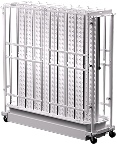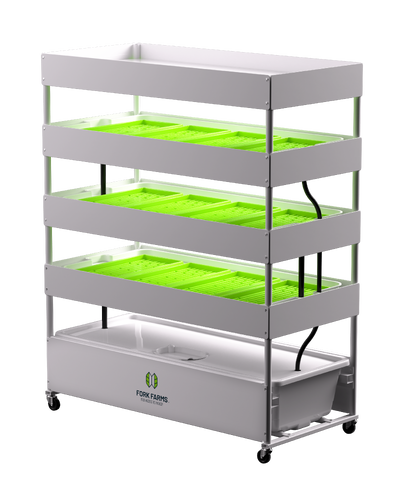The Future of Hydroponic Farming: Trends and Innovations from Fork Farms
As we look further into 2025, it’s interesting to think about the future of hydroponic farming and reflect on various trends and innovations we’ve seen in recent years. In a world where sustainability and food security are at the forefront of global concerns, hydroponic farming has emerged as a groundbreaking solution to feed more people in a sustainable manner. Fork Farms is a leader in this space as the food access company continues to push boundaries with innovations that make fresh, nutritious food accessible to all at all times.
According to industry research, the hydroponic market is poised for significant growth due to several key factors, including a consistently increasing global population, limited availability of cultivable land, government incentives, and a rising demand for fresh, high-quality food. Notably, approximately 80% of the world's population resides in urban areas, as reported by the World Health Organization (WHO) and the Population Council. The scarcity of land in urban settings has spurred the adoption of innovative solutions like hydroponics. This method empowers growers to optimize various spaces for cultivating crops, whether it be indoors using layered systems, in multi-story buildings, on stacked racks, or within warehouses.
Here's a look at the trends and advancements shaping the future of hydroponic farming and how Fork Farms is leading the charge.
Democratizing Food Production
Hydroponic farming allows food to be grown in locations where traditional agriculture is impractical. Regardless of things such as climate, natural disasters, light hours, and available space with good soil, hydroponic systems allow for growing fresh foods year-round. Fork Farms' Flex Farm systems are compact, efficient, and designed to thrive in school, health care, food service, community service, hospitality, and home settings. By bringing farming indoors and closer to consumers, these systems are reducing food miles and empowering individuals to grow their own produce. Unfortunately, it is estimated that fresh produce in the United States travels about 1,500 miles to get from farm to plate, but if food is grown locally or on-site, there are no transportation costs, and most of the time there is very little storage space needed since fresh food can go from harvest to plate within minutes. In 2023, our Flex Farms saved 4.6 million food miles since they grow fresh food anytime, anywhere.
Why it matters: Localized food production enhances community resilience, reduces reliance on supply chains, and ensures access to fresh produce year-round.
Leveraging Technology for Efficiency
The integration of smart technology is a growing trend in hydroponics, and Fork Farms is no exception. At Fork Farms, we feed the future with food access technology. Automated systems monitor and adjust light, water, and nutrient delivery for optimal plant growth in our innovative hydroponic growing systems. This precision reduces waste and ensures consistent quality, even for users with little farming experience. Our Flex Farm and Flex Acre are designed to be user-friendly and scalable, enabling individuals and organizations to grow healthy food sustainably, regardless of their technical expertise.
Sustainability at the Core
Traditional agriculture often relies heavily on water, land, and chemicals. Hydroponic systems, by contrast, use significantly less water and require no soil, minimizing environmental impact. Fork Farms takes sustainability a step further than most. Our Flex Farms boast industry-leading energy efficiency, using 4.6kWh per pound of food grown, whereas the industry standard uses 18kWh per pound. In general, indoor hydroponic farming uses between 80% and 90% less water than traditional farming practices; our Flex Farms use 98% less water than traditional farming.
As climate change and population growth put pressure on global food systems, hydroponic farming offers a sustainable way to feed the world without depleting natural resources. Fork Farms has proactively developed new and innovative ways to grow food. A Flex Farm is a highly scalable, mobile vertical growing system that can grow 25 pounds of lettuce every 28 days while only requiring 9 square feet of space and a standard electrical outlet for operation.
Educational Opportunities
Hydroponics is not just about growing food; it’s about growing knowledge. Schools using Fork Farms' systems are incorporating hands-on STEM learning into their curricula, teaching students about biology, chemistry, and sustainability.
By combining hands-on experimentation in real-world farming scenarios, interdisciplinary learning, and technology, hydroponics provides numerous benefits for students' engagement, critical thinking, and problem-solving skills. Students are presented with a wealth of learning opportunities while becoming advocates for sustainable living—a win for both education and the environment.
To learn about the impact of our hydroponic growing systems, check out some of our partner’s impactful stories.
Caribbean Climate Smart Agriculture Project
Expanding Crop Varieties
Hydroponic farming has traditionally been associated with growing leafy greens, but innovations are expanding its potential. Fork Farms and other leaders in the industry are exploring systems that can grow a wider range of crops, including fruits, herbs, edible flowers, and even some root vegetables. We’ve had partners grow strawberries, peas, peppers, cucumbers and more. Diverse crop options mean that hydroponic farming can cater to a broader spectrum of nutritional needs and culinary preferences, making it a versatile solution for communities worldwide.
The Fork Farms Vision for the Future
Fork Farms envisions a world where fresh food is accessible to everyone, everywhere. We are committed to innovation, education, and sustainability to be a true leader in the fight against food insecurity. By empowering individuals and communities to take control of their food supply, we are not just shaping the future of hydroponic farming—we are redefining the future of food.
Whether you're a teacher looking to inspire students, a business owner seeking sustainable solutions, a non-profit looking for ways to better nourish your community, or simply someone passionate about fresh, healthy food, Fork Farms is leading the way and dedicated to helping our partners make positive change. The future of farming is here, and it’s green, efficient, and within reach.
Are you ready to join the hydroponic revolution? Learn more about how Fork Farms is transforming the way we grow food.
We have what you need to make a positive impact right now. Our team is here to provide one-on-one support every step of the way. Let's Get Growing.























